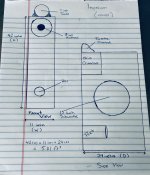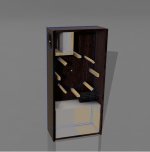While recently revisiting an old notebook, I came across a set of conceptual sketches I developed approximately a year ago for a high-output floorstanding loudspeaker system. The original design intent was to engineer a compact yet powerful three-way speaker capable of delivering clean, high-SPL performance—targeting sustained output levels exceeding 100 dB—with minimal distortion across the audible spectrum.
The central design philosophy was to strike a balance between physical footprint and acoustic authority. I aimed to create a speaker that could serve in both casual hi-fi and more dynamic, “party”-style listening scenarios—capable of high output without compromising composure, tonal integrity, or transient fidelity. In essence, the goal is a speaker that "sounds bigger than it looks."
Specifically, I’m seeking feedback on the following:
The central design philosophy was to strike a balance between physical footprint and acoustic authority. I aimed to create a speaker that could serve in both casual hi-fi and more dynamic, “party”-style listening scenarios—capable of high output without compromising composure, tonal integrity, or transient fidelity. In essence, the goal is a speaker that "sounds bigger than it looks."
Preliminary Driver Selection:
At the time of concept development, I had tentatively selected the following transducers based on a combination of efficiency, bandwidth, and cost-to-performance ratio:- Woofer: GRS 15SSW-4HE 15" High-Efficiency Subwoofer – Side-mounted for enclosure optimization and to enable extended low-frequency response.
- Midrange: Dayton Audio PM220-8 – A high-sensitivity 8" paper cone driver known for its smooth midband performance.
- Tweeter: ScanSpeak Discovery D2604/833000 – A 1" textile dome tweeter, chosen for its excellent dispersion, refined top-end, and low distortion characteristics.
Enclosure & Design Objectives:
The cabinet volume is currently modeled at approximately 5 cubic feet (~141 liters), which allows the 15" woofer to achieve substantial low-end extension while minimizing excursion-related distortion at high output. The narrow front baffle is intended to aid imaging and maintain domestic compatibility, while the overall height and internal volume support proper driver alignment and acoustic loading.Moving Forward:
I've recently decided to pursue this design and bring it into the build phase. I possess a solid foundational understanding of speaker design principles—such as crossover topology, enclosure tuning, and driver integration—but I would greatly appreciate the insights and critiques of fellow forum members to validate my approach.Specifically, I’m seeking feedback on the following:
- Appropriateness of the chosen drivers for this application and synergy in a 3-way configuration
- Potential crossover challenges or suggestions (especially integrating a large-format mid with a dome tweeter)
- Cabinet tuning recommendations or alternate alignment considerations
- Suggestions for improving directivity control and power handling under high-output conditions
Attachments
Your selected mid has a pretty severe dip near 2k. That will make crossing to the tweeter difficult, and that tweeter needs a higher x-over for high SPL use.
Yup...
Use a tweeter that fits in one of these waveguides.
https://www.somasonus.net/waveguides
Then you might possibly cross low enough for that 'midrange'.
Remember that good on-axis is not enough for a good sounding speaker
Use a tweeter that fits in one of these waveguides.
https://www.somasonus.net/waveguides
Then you might possibly cross low enough for that 'midrange'.
Remember that good on-axis is not enough for a good sounding speaker

